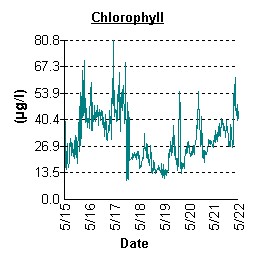|
May 21, 2003
Mahogany tide lingering in Rockhold Creek (Anne Arundel County) region; lesson about the effects of blooms on water quality. |
|
The bloom of the dinoflagellate Prorocentrum minimum that was first sampled on 5/7/03 (see 5/13/03 Mahogany Tide Bloom in Rockhold Creek, Deale, MD) continues to tint the color of Rockhold Creek and Tracy’s Creek reddish-brown. On Tuesday, 5/20, one sample was collected at the public boat launch in Deale and contained 68,635 cells/ml of Prorocentrum, an increase from last week and evidence that the bloom is still strong in the region. The local significance of such a bloom of algae is the impact to water quality and specifically levels of dissolved oxygen to living resources. As an example, Maryland DNR has a continuous water quality monitoring station located at Ben Oaks on the Severn River. When algae bloom (i.e., increase their population numbers significantly) while the weather is sunny, oxygen levels increase due to oxygen accumulating in the water from the process of photosynthesis. On cloudy days, less oxygen may be produced than is consumed and DO levels decline. These relationships are evident during the period between May 15th and the 21st at the Ben Oaks Continuous Monitoring site.
Chlorophyll provides an index to algal populations. In the graphs above, the algal populations increased on May 15 and then maintained significant levels on May 16th-17th. From May 17th –19th we had a cloudy, rain-filled weekend. Consequently, dissolved oxygen levels declined as photosynthesis was not keeping pace with the processes of respiration and decomposition that consume dissolved oxygen. On May 19th dissolved oxygen levels briefly dip to 2.5 mg/L, levels very stressful to most fish and shellfish. On May 20th and 21st, we had sunshine again, algae levels started to increase and oxygen levels increased once more. If temperatures were higher, the rate of oxygen decline could be even more drastic during this week and lower oxygen levels might have been reached. The relatively cool spring waters have slowed the pace of respiration and decomposition versus summer conditions. These rather large shifts in water quality conditions in response to the weather conditions and algae concentrations over the week illustrate the tight linkage between the algal blooms and water quality. The smaller fluctations within a day demonstrate more subtle changes occurring during tidal shifts and night versus daylight hours. Such algal blooms are further fueled by nutrients. Fewer nutrients typically results in fewer and less intense blooms in regions. By reducing these large biomass, broad distribution algal blooms, we would expect less stressful conditions for Bay life during the year. To learn more about
how the Bay monitoring data shows changes in important water quality parameters,
please visit the Monitoring Stories
and Highlights section of Eyes on the Bay. |


